Tatti
A Maremma medieval village of 100 doors
The medieval village of Tatti in the metalliferous hills of Maremma near Massa Marittima is something of a mystery: a tranquil Tuscany village on the top of a wooded hill with its own castle in which the only sounds are those of an elderly lady sat in her doorway or a sleeping cat stretching. Its castle and ancient city walls hold to this day the secret of its early history.
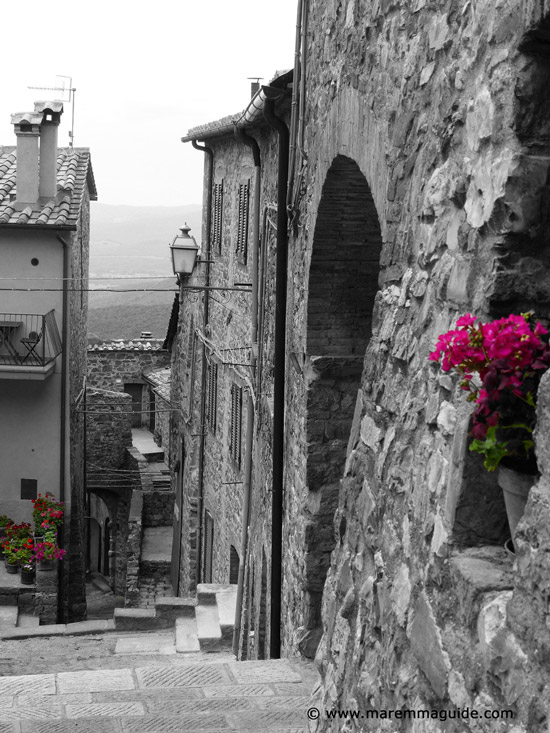
Very little is known about the early history of the village: although fragments of Etruscan pottery have been found in the area and would suggest a settlement linked with nearby important Etruscan city of Vetulonia, nothing more concrete has been found.
The earliest documentary evidence is from the middle ages, at the end of the ninth century, and that contains scant information.
But the mystery of Tatti for me lies in its doors.
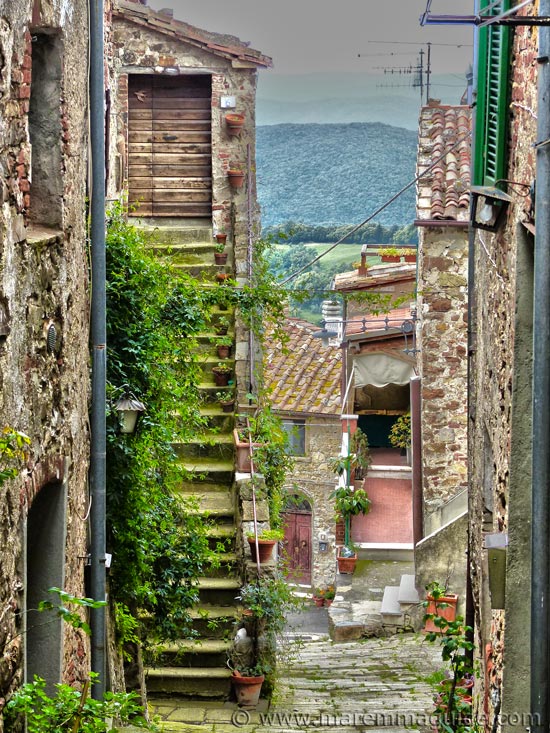
I have visited many medieval Tuscany towns and villages and have been enchanted by nearly every one of them, but none have invoked such a sense of curiosity entering their medieval gateways as Tatti has. For such a small place, its historic medieval centre - which is so well preserved it is much as it would have been 900 years ago - has a profusion of doors, the quantity of which in such a few square metres I have never come across before.
Each one is only a few inches away or set directly at ninety degrees from another. Notwithstanding that originally many of the lower entrances would have been access for storage and animals, the number of homes squeezed into one place is just incredible.
And then there is an incredibly narrow passageway: the narrowest medieval alleyway I have ever seen. And very low arched passages that are passable only on knees with stooped heads.


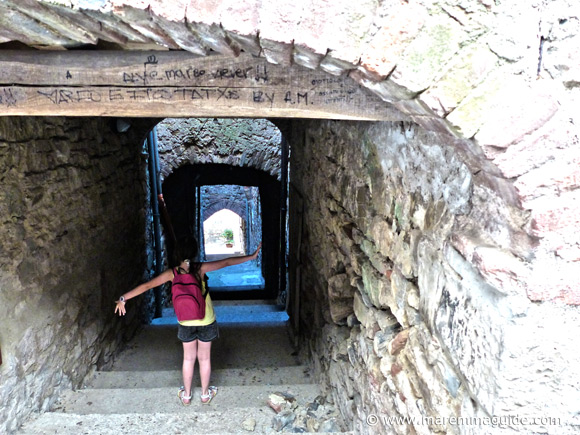 Going down...
Going down...
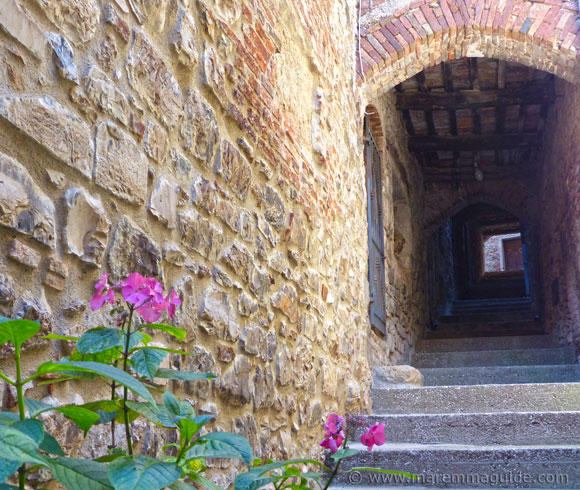 Looking up.
Looking up.
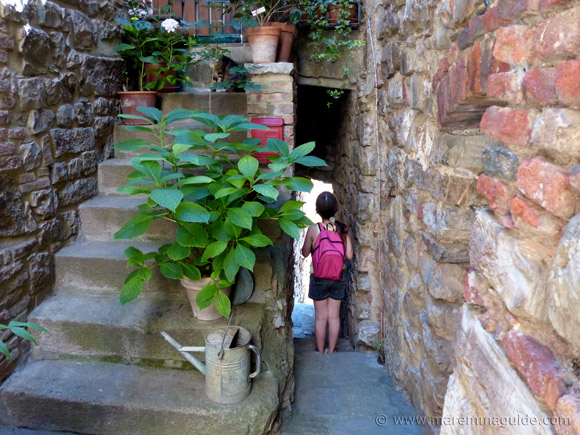 The narrowest one.
The narrowest one.
My first visit left me captivated and wondering who and how many people had lived within the protection of its walls.
And then by chance I met a Maremma photographer who was born in there and he told me that, although he had lived along the coast in Follonica for the most part of his life, his heart still belonged to his birth place, to which he returned often. Which led him to tell me of the legend of the well in the centre of the village.


So one Saturday afternoon during a glorious Spring weekend in Maremma in Tuscany, I returned to take another look. And I have been back many times since.
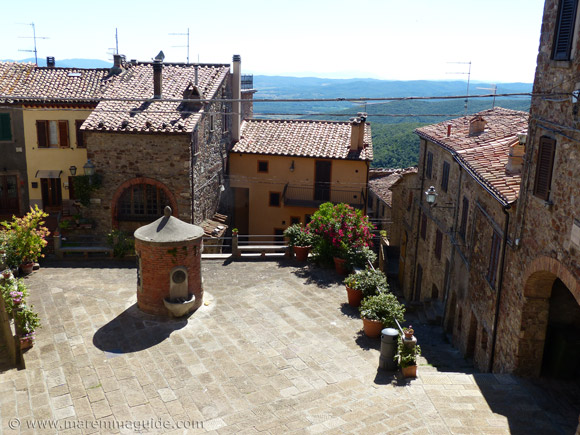
The colours of Spring in Tuscany in Tatti: one of the best times to visit Italy.


The history
 Plan from the old land registry of Lorenese (1824). The course of the curved line of the houses traces the city wall of the original fortified centre, on top of which stands "la rocca" - the fort.
Plan from the old land registry of Lorenese (1824). The course of the curved line of the houses traces the city wall of the original fortified centre, on top of which stands "la rocca" - the fort.The Italian text in the boxes is taken from the information board provided by the Comunita Montana Colline Metallifere; each of the English translations below each box are my best effort!
Un centro rurale fra miniere e transumanza
"Nonostante le ricostruzioni subite nel corso dei secoli, l'andamento curvilineo delle case del centro storic consente di cogliere il percorso del circuito delle mura in una loro fase medievale; in corrispondenza dell'attuale via A. Cappelletti, si apre inoltre nelle mura una porta con arco in pietra a tutto sesto, originariamente provvista di piombatoi.
L'area sommitale dell'abitato e occupata da un grande complesso architettonico fortificato organizzato attorno ad un cortile, al quale si accede attraverso due porte ad arco tondo in arenaria. Questo ridotto fortificato, nel cui angolo nord-orientale si erge anche una torre provvista di un'alta base a scarpa, e identificabile con il cassero del castello e la sua versione attuale e frutto di una serie di massicci interventi realizzati durante gli ultimi decenni del Trecento dalla famiglia senese dei Malavolti. Nel borgo, tra il cassero e la sottostante cisterna, ha sede la pieve di Santa Maria, un edifico medievale di originario impianto gotico in buona parte ricostruito, del quale rimangono alcuni lacerti lungo la parete destra della chiesa. Nell'abitato di Tatti avevano sede anche la chiesa di San Sebastiano, situata all'interno della mura, e quella della SS. Annunziata situata al loro esterno. "
A rural centre between mining and transhumance
Despite the reconstructions made over the centuries, the curve of the houses of the historical centre still take the path of the circuit of their medieval walls. At the current Via A. Cappelletti, there is an arched door within a stone archway, which was originally provided with lead missiles.
The summit area of the town is occupied by a large fortified architectural complex organized around a courtyard, which is accessed through two ports in round-arched sandstone. In the north-eastern corner of this small fortress stands a tower built upon a high scarp base, identifiable as the keep of the castle. Its current version is the result of a series of massive interventions made during the last decades of the fourteenth century by the Sienese family of Malavolti.
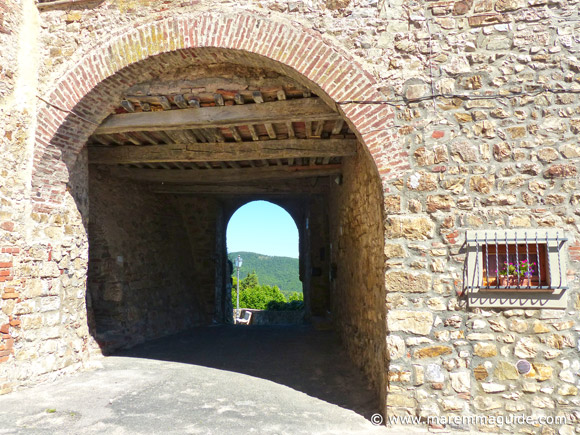
 The entrance to Tatti castle and its courtyard.
The entrance to Tatti castle and its courtyard.In the village, between the keep and the underground cistern, is the parish church of Santa Maria. A medieval building of original Gothic plan it was largely rebuilt, but some fragments of the original construction remain along the right wall of the church. The inhabitants of Tatti also have the church of San Sebastian, located inside the walls, and that of SS. Annunziata located outside of them.
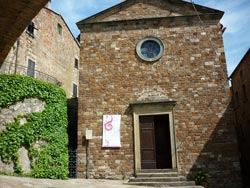 Chiesa di Santa Maria Assunta
Chiesa di Santa Maria Assunta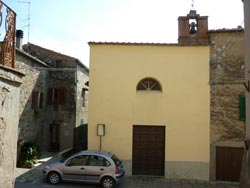 Chiesa di San Sabastiano
Chiesa di San Sabastiano
I documenti
"Alla fine del secolo IX risale la prima menzione dell'abitato di Tatti, quando venne ricordato un tale 'Gumpulo de tatte' che era tenuto a prestare delle corvees, per tre giorni alla settimana, a vantaggio dell'azienda di proprieta del vescovo di Lucc situata nell'area del Lago dell'Accesa."
The Documents
The first mention of the town is at the end of the ninth century, when it was recalled that someone called 'Gumpulo de feel' was required to work the "corvees" for three days a week, to the benefit of the property located in the area of the Lago dell'Accesa of the bishop of Lucca.
Il dominio dei conti Aldobrandeschi e dei conti Pannocchieschi sul castello
"Non e nota la data di fondazione del castello, ma sappiamo che esso esisteva gia nell'anno 1216 quando fu inserito nella spartizione del patrimonio aldobrandesco. A questa famiglia apparteneva il conte Ildebrandino di Guglielmo che nel 1268 concesse in feudo il castello di Tatti a Bernardino di Gherardo da Perolla, dei conti Pannocchieschi."
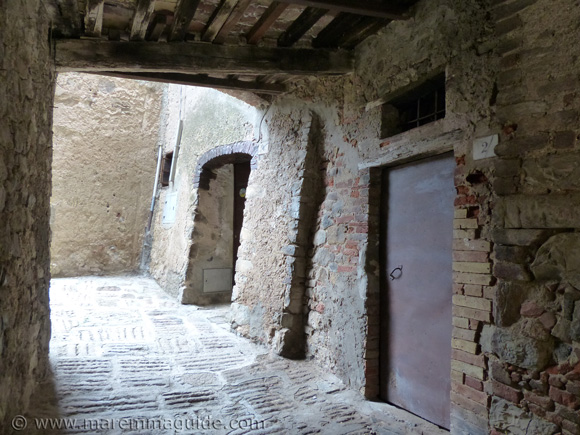
The rule of the Counts of Aldobrandeschi and the Counts Pannocchieschi over the castle
The date of the foundation of the castle is not known, but it is known that it already existed in 1216 when it was included in the division of the assets of the Aldobrandeschi family. Ildebrandino di Guglielmo belonged to this family and in 1268, he granted the castle of Tatti to Bernardino di Gherardo da Perolla, of the Counts of Pannocchieschi.
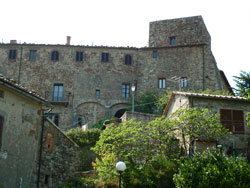
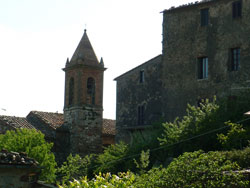

Le miniere del territorio
"Secondo una fonte duecentesca Ildebrandino di Guglielmo, degli Aldobrandeschi di Sovana e Pitigliano concesse in feudo a Bernardino del fu Gherardo da Perolla il castello di Tatti con le annesse miniere di argento. Effettivamente, non lontano dal castello erano state rinvenute mineralizzazioni metallifere: un inventario delle miniere della Repubblica di Siena redatto tra il 1548 ed il 1552 attesta infatti che nel territorio di Tatti, a distanza di circa 2 miglia dall'abitato, era in attivita una miniera d'argento. Una nota redatta pochi anni dopo, fa inoltre riferimento al rinvenimento di un campione do 'margassita di Tatti'."
The mines of the territory of Tatti
According to a thirteenth century source, Ildebrandino di Guglielmo of the Aldobrandeschi family of Sovana and Pitigliano, granted Bernardino of the late Gherardo da Perolla the castle of Tatti with the attached silver mines. Indeed, not far from the castle, metalliferous mineralization was re-discovered: an inventory of mines in the Republic of Siena written between 1548 and 1552 attests to that fact in the territory of Tatti, a distance of about 2 miles from the town, was an active silver mine. A note written a few years later, also refers to the discovery of a specimen called 'margassita Tatti'.
Tatti today
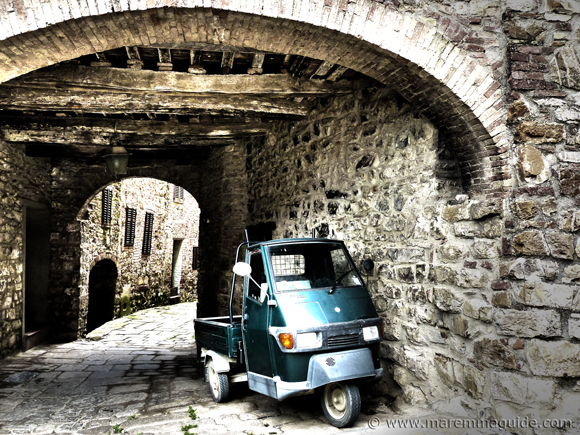
Until the final closure of Maremma's mines in the late 1980's/early 1990's, mining remained the principle activity of the residents of the village. Now it is a place of mainly retired folk and a few second homes belonging to those from neighbouring European countries who have found and love Maremma.
The last time I walked around there were a few homes - some in need of renovation - for sale: perfect hideaways for those seeking tranquility and solitude in an undiscovered part of Tuscany.
For Tatti is pure tranquility in a breathtaking setting. With stunning panoramic views to the neighbouring hill top castle of Montemassi and the hamlet of Sticciano. They extend to the Tuscan coastline, the archipelago islands, and Corsica.
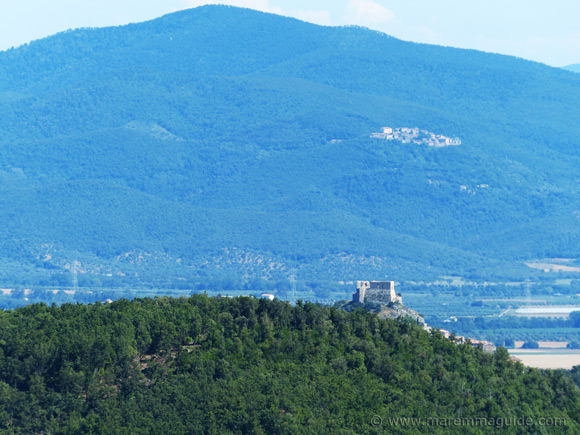
The doors
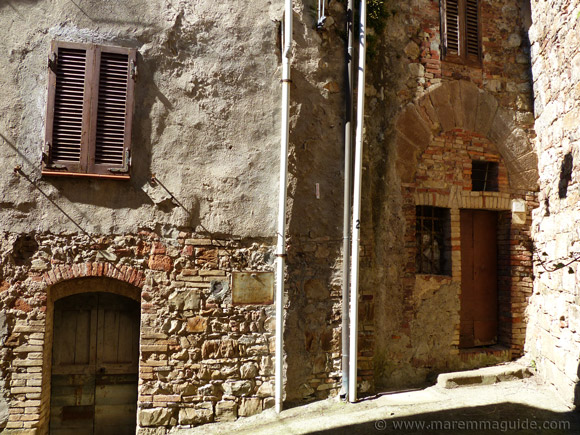
Try counting them for yourself! If you walk up the first steep steps towards the centre of Tatti (just follow the historic centre sign from the southern end of the village), as you take the two ninety degree turns along the path to reach the first main arched gateway start counting: I stopped when I reached 100!
Four in this photograph.
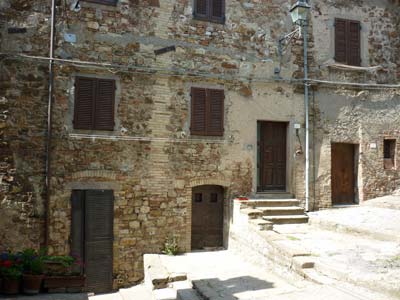
This one in need of some tender loving care (renovation) and deep pockets!
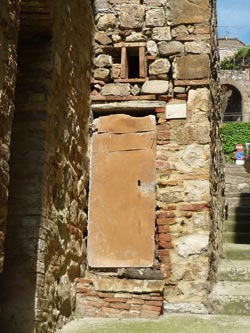
 One within the deep arched entrance to the castle.
One within the deep arched entrance to the castle. One to a "cantina" (cellar) that even bending over double I couldn't get through.
One to a "cantina" (cellar) that even bending over double I couldn't get through.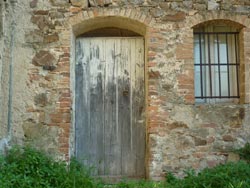 One more.
One more. An impressive one as you enter the medieval centre.
An impressive one as you enter the medieval centre.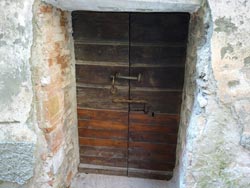
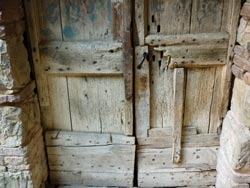 One with a lovely old and worn wooden door.
One with a lovely old and worn wooden door.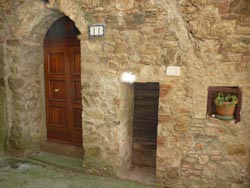 Two.
Two.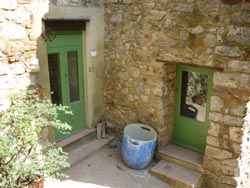 Two more in a renovated house.
Two more in a renovated house.
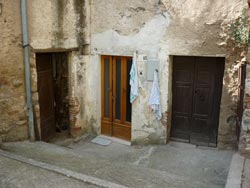 Three.
Three. Three more and with the narrowest medieval passageway to the third that I have ever seen in Italy: I would need to squeeze through sideways to pass through!
Three more and with the narrowest medieval passageway to the third that I have ever seen in Italy: I would need to squeeze through sideways to pass through!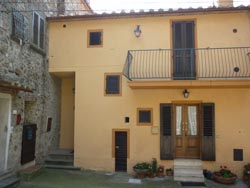 Three in this renovated house: one is up the steps and around the corner.
Three in this renovated house: one is up the steps and around the corner.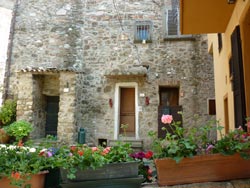 And three in the original stone building attached to it.
And three in the original stone building attached to it. Seven.
Seven.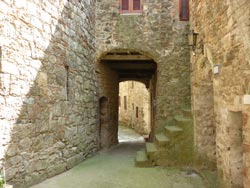 Six, counting those that require you to see up steps in this photo!
Six, counting those that require you to see up steps in this photo! Eight (one behind the climbing rose).
Eight (one behind the climbing rose).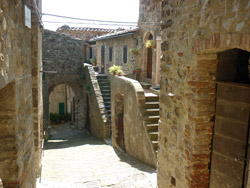 ... and ten in this one.
... and ten in this one.And there are many more!

The Video
Events
 Photo courtesy of bonizios.
Photo courtesy of bonizios.The "Sapori d'Autuno" - Tastes of Autumn event is held during the first weekend of November each year with displays of local artists work, street artists, Maremma speciality foods, and a wonderful opportunity to visit the ancient cellars behind some of the doors pictured above!
Check this Maremma events page for the actual dates and further details for each year.
Places to eat
 Ristorante e Pizzeria Il Barrino.
Ristorante e Pizzeria Il Barrino. The lovely public garden with welcome shade during the day and a view of the castle keep, original double arched entrance way and fortified walls
The lovely public garden with welcome shade during the day and a view of the castle keep, original double arched entrance way and fortified wallsLike most Tuscany villages, Tatti has two bars. One of which - the Il Barrino - is also the local restaurant and pizzeria with a large covered terrace with great views of the surrounding Maremma countryside.
Or, if you have a picnic with you, there is a pretty and well attended small public garden directly opposite the Il Barrino with a view of the castle above.
A special place to stay
A really special place to stay. Just down the road - you can gaze at Tatti from the swimming pool or even trek on horse-back to it - is a beautiful Tuscany villa that will leave you wanting for nothing. The kind of place that you take your girlfriend to to propose, or your wife on an anniversary. Or just when you want to relax big time and not think about food shopping or cooking. Or driving anywhere even.
This isn't self-catering, this is living in an Italian wine estate and feeling like a king :)

Explore some more...
















